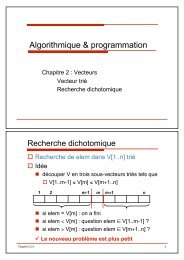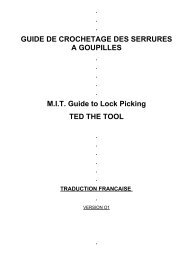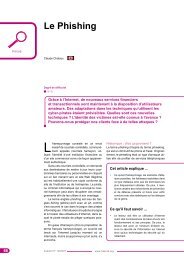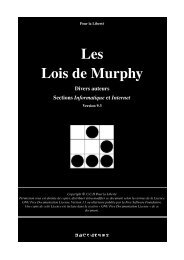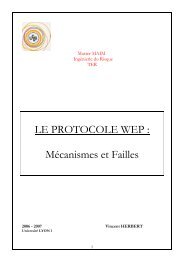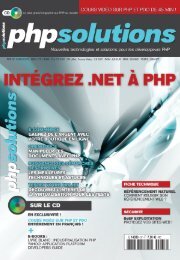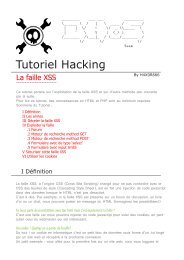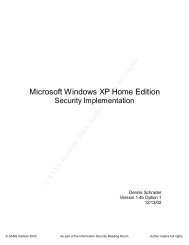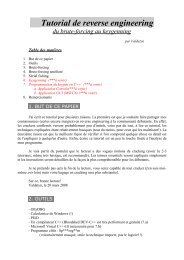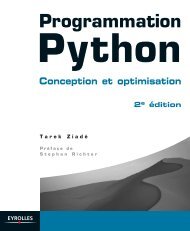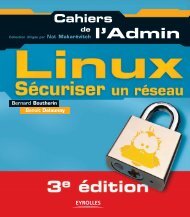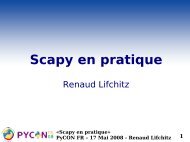How to Steal an Election by Hacking the Vote - repo.zenk-securit...
How to Steal an Election by Hacking the Vote - repo.zenk-securit...
How to Steal an Election by Hacking the Vote - repo.zenk-securit...
Create successful ePaper yourself
Turn your PDF publications into a flip-book with our unique Google optimized e-Paper software.
http://arstechnica.com/articles/culture/evoting.ars<br />
The basic idea behind <strong>the</strong> chart is that you c<strong>an</strong> place a bad apple in <strong>an</strong>y one of <strong>the</strong><br />
boxes, <strong>an</strong>d <strong>an</strong>y number of <strong>the</strong> voting machines within that region could be<br />
compromised. The "third party system software" referenced in <strong>the</strong> outermost box<br />
could be <strong>an</strong>y third party software, like <strong>an</strong> multiple vendor (here Diebold <strong>an</strong>d ES&S,<br />
for example). Finally, note that <strong>the</strong> counties <strong>an</strong>d precincts are sized differently, just<br />
<strong>to</strong> show some variation.<br />
If you w<strong>an</strong>ted <strong>to</strong> steal <strong>an</strong> election, <strong>the</strong> best place <strong>to</strong> drop a bad apple would be at a<br />
popular operating system vendor. E-voting expert Douglas Jones has proposed <strong>the</strong><br />
following such scenario, merely as <strong>an</strong> example <strong>to</strong> show what's possible:<br />
In <strong>the</strong> next version of <strong>the</strong>ir window m<strong>an</strong>ager, a major vendor<br />
includes a little bit of code as part of <strong>the</strong> "open new window on<br />
screen" mech<strong>an</strong>ism. If <strong>to</strong>day is <strong>the</strong> first Tuesday in November of <strong>an</strong><br />
even numbered year, this code checks <strong>the</strong> contents of <strong>the</strong> window. If<br />
<strong>the</strong> window contains <strong>the</strong> strings "Straight Party", "Democrat",<br />
"Republic<strong>an</strong>", "Socialist", <strong>an</strong>d "Reform", <strong>an</strong>d if <strong>the</strong> window contains a<br />
"radio but<strong>to</strong>n" widget, allowing <strong>the</strong> selection of one out of n<br />
alternatives, <strong>the</strong> software would, one time out of ten, exch<strong>an</strong>ge <strong>the</strong><br />
words "Republic<strong>an</strong>" <strong>an</strong>d "Reform".<br />
What does this little bit of code do? On election day, <strong>an</strong>d on no o<strong>the</strong>r<br />
day, it throws ten percent of <strong>the</strong> straight party Republic<strong>an</strong> vote <strong>to</strong> a<br />
large third party that is known <strong>to</strong> attract m<strong>an</strong>y Republic<strong>an</strong>-le<strong>an</strong>ing<br />
voters. In closely contested Democratic-Republic<strong>an</strong> contests, this<br />
could easily swing <strong>the</strong> outcome <strong>to</strong> favor <strong>the</strong> Democrats, <strong>an</strong>d on a<br />
national scale, it could easily provide <strong>the</strong> winning margin for control<br />
of Congress or <strong>the</strong> White House...<br />
This kind of attack does not require ei<strong>the</strong>r massive conspiracy or<br />
corporate approval or cooperation! So long as a single programmer<br />
c<strong>an</strong> covertly incorporate a few lines of simple code in<strong>to</strong> a component<br />
that he or she knows will end up in a large fraction of all voting<br />
machines, <strong>an</strong>d so long as that code is not subject <strong>to</strong> exhaustive<br />
inspection, <strong>the</strong> system is vulnerable! Someone intent on fixing <strong>an</strong><br />
election does not need <strong>to</strong> buy <strong>the</strong> support of <strong>the</strong> comp<strong>an</strong>y, <strong>the</strong>y only<br />
need <strong>to</strong> buy <strong>the</strong> support of one programmer with access <strong>to</strong> a key<br />
component!<br />
If you don't think that it's possible someone <strong>to</strong> buy off, say, a Microsoft employee<br />
with access <strong>to</strong> <strong>the</strong> right window m<strong>an</strong>ager libraries, or you think that Microsoft would<br />
eventually catch <strong>the</strong> crack with a source code review (even in spite of clever<br />
obfuscation on <strong>the</strong> part of <strong>the</strong> mole), <strong>the</strong>n you'll be heartened <strong>to</strong> know that Jones<br />
has confirmed my suspicion that a virus could easily make <strong>the</strong> modification described<br />
above... or, it could make some o<strong>the</strong>r, equally clever modification that no one has<br />
thought of yet. All that's needed is <strong>to</strong> get <strong>the</strong> virus on<strong>to</strong> a machine at a DRE vendor<br />
that houses builds of one or more layers of <strong>the</strong>ir DRE's software stack, <strong>an</strong>d you have<br />
<strong>the</strong> capability <strong>to</strong> do undetectable wholesale fraud.<br />
This last point brings me <strong>to</strong> next region in<strong>to</strong> which a bad apple could be profitably<br />
inserted: <strong>the</strong> DRE vendor (or <strong>the</strong> vendor's network). There's no need <strong>to</strong> say much<br />
more about this, though, because most of <strong>the</strong> article has been taken up with this<br />
type of scenario. Bad apples in this area c<strong>an</strong> commit undetectable wholesale fraud.<br />
Copyright © 1998-2006 Ars Technica, LLC<br />
20




